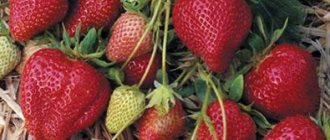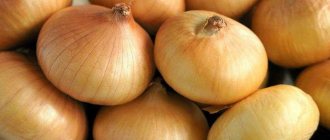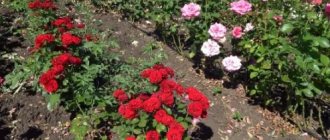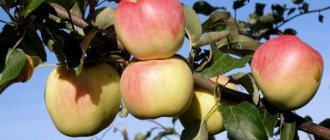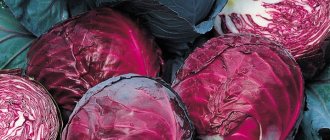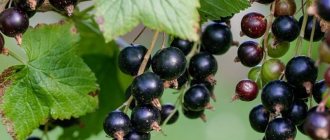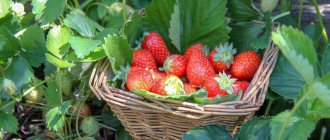Frost-resistant blackberry varieties
Nurseries in Yekaterinburg offer local gardeners the best of frost-resistant plants:
- Agave is a long-known variety in Russia that can withstand frosts down to -40 degrees. Plants are resistant to rust and anthracose. The yield is average (up to 4 kg per bush with a berry weighing 3 g), but stable;
- Chester Thornless is considered a promising variety for harsh regions. Its shoots are thornless and the yield is average. Withstands cold temperatures down to -30 degrees and requires shelter for the winter, but will take root well in Siberia;
Chester Thornless variety
- Darrow is another representative of a frost-resistant variety that is popular among Ural gardeners. It can easily withstand air temperatures down to -35 degrees, but in severe winters shelter is recommended.
Varieties such as Black Satin, Thornfree, Izobilnaya are considered to be moderately resistant, but feel good in cold regions when grown under shelters.
On a note. In order for blackberries to take root in Siberia, planting and care are carried out in strict compliance with the rules of agricultural technology. This allows you to protect the bush from freezing and ensures good harvests.
When to open bushes after winter
Oddly enough, but such a seemingly easy procedure as opening plants after winter requires experience and endurance. Early and late openings do not always have a beneficial effect on shrubs. Here it is necessary to choose the “golden” mean depending on weather conditions. If you choose an early opening date, then it must be done immediately after the snow melts. But at the same time, it is recommended not to tie the branches with trellises for the first 2 weeks, but to wait until they are warmed up by the sun’s rays.
To prevent night frosts from damaging the bushes, they can be covered with a breathable layer of agrofibre.
If opening early is not so important for you, you can wait a little and open later, while periodically opening the shelter for air access. The most optimal period for removing the cover is considered to be mid-spring, when 2-3 weeks have passed since the snow melted. This period may shift depending on climatic conditions. Removing the cover during this period will not affect the timing of fruit ripening.
We recommend reading when to remove winter cover from blackberries.
When is the best time to plant
Grapes in Siberia for beginners: planting and care
When growing berry crops, you should take into account the peculiarities of the local climate. In regions located beyond the Urals, winter comes early. This prevents the bushes from taking root normally when planting in the autumn. Therefore, it is recommended to plant blackberry seedlings in spring in Siberia.
It is allowed to carry out planting work in the fall in heated greenhouses, where the sprouts will remain until the end of winter. As soon as the ground warms up enough in the spring, the seedlings are transferred to a permanent place in the garden.
How to care
Within six months from the moment the bush was planted, shoots formed on it. They are strong enough to produce a rich harvest. This happens closer to autumn. Throughout spring and summer, it is necessary to provide the bushes with proper care.
To do this, you have to constantly loosen the soil. This must be done in order to saturate the root system with oxygen. Loosening is carried out between adjacent shoots concentrated on one row.
If the bushes are two years old and have already borne fruit, then they need to be pruned regularly. In the fall, create a shelter for the berry plant so that it does not freeze in winter. Every year during spring, blackberries need to be fed. For this purpose, urea is used. There are 25 g per 1 m2. Once every 3 years, fertilize the bushes with humus. 10 kg of fertilizer is applied to each bush. It will also be useful to learn about how blackberries are grown and cared for in the Urals.
Video shows how to care for blackberries:
For full growth, regular watering will be necessary. However, it should be moderate, since stagnation of water will lead to the death of plants. But the soil should not dry out, as this will prevent the bush from blooming and bearing fruit.
For several years, water the plant using the fan-shaped method. But lift the growing loops and tie them up. And young shoots that have just begun to grow should be directed to the center of the bush. In autumn, blackberries do not bear fruit, so it is necessary to prepare the bushes for wintering. Old shoots must be cut off completely.
Cover each bush with a special material. Most often, spruce branches, foliage or sawdust are used. If this is not done, the plant will not survive winter frosts and will die. The same applies to frost-resistant varieties. Without full protection, the bushes will suffer greatly.
As soon as spring comes, free the bushes from the protective coating. This manipulation must be performed before the buds form. After this, you can give the bush a shape and lift the growing shoots. Carry out similar activities until the bushes begin to bear fruit.
Where to plant on the site
Corn in Siberia: planting and care
Despite the family relationship with raspberries, blackberries are more demanding when choosing a location. The crop needs plenty of sun (especially when growing blackberries in Siberia) and protection from the winds. The depth of underground streams should also be taken into account - waterlogged soils are not suitable for the plant.
To grow a good blackberry plantation in the Urals and Siberia, you will have to take care of the fertility of the site. Over-acidified and heavy soils are not suitable for the crop. The best conditions are black soil, but loams with a high humus content will also work.
Note! Experienced gardeners manage to grow good crops on depleted soils by properly fertilizing
When choosing a location for blackberries, the proximity to other crops is also taken into account. Trees located nearby will shade the berry garden, which will negatively affect the quality of the fruit and can lead to diseases of the bushes.
The best neighbor for blackberries would be raspberries - these crops have good compatibility. The main thing is to maintain a distance between plantations of at least 1.5 m, so that the bushes do not interfere with each other’s development.
Important! To avoid diseases of blackberry bushes, they should not be planted near vegetable gardens. It is not recommended to use former vegetable beds - fungal spores and pest larvae remain in the ground after their predecessors.
Planting blackberries at a dacha in Siberia
It is recommended to choose areas protected from negative external factors. Plants do not tolerate drafts or strong winds, especially in winter. The most suitable places are along the fence near buildings, but you should not choose completely shaded areas of the garden. Lack of sun will increase the ripening period of plants. If the dacha is not planted with trees, choose any area that is closed from drafts and accessible to sunlight. It is recommended to plant blackberries in autumn or spring. Adviсe:
- the site is excavated to a depth of 1 shovel bayonet;
- the soil is fertilized, the composition of the additives: ash, superphosphate, potassium sulfide;
- it is important to determine the level of soil acidity; if the level is elevated, lime is added; such manipulations are carried out long before planting the seedlings (at least 30 days);
- cuttings are planted when the frosts have completely passed, taking into account the quality of the soil: if it is very moist, they form a bed; if the soil is dry, they create ruts; it is not recommended to completely cover the cuttings with soil;
- when it is planned to plant a semi-creeping shrub, trellises are first installed, blackberries are placed on both sides of them;
- before lowering the cuttings into the recesses, first lay humus on the bottom and mix it with soil;
- when the planting procedure is completed, the plants are watered and the above-ground part is also cut off, leaving no more than 3 buds on the cutting.
Pre-planting work
Plum in Siberia: planting and care
Before planting seedlings is planned, gardeners carry out preparatory activities in the fall:
- unnecessary plants are removed from the site;
- all rhizomes are uprooted;
- Weedy perennials are destroyed.
Autumn site preparation
The final stage of pre-planting work is digging up the entire area allocated for the berry garden. The depth is maintained at a full bayonet of a shovel. Fertilizers are scattered evenly over the bed (15 g of superphosphate, 20 g of potassium sulfate, a bucket of humus for each square meter) and raked into the soil.
Agricultural technology
Caring for blackberries is no different from many other fruit-bearing shrubs in your garden. For experienced gardeners, this activity will not be difficult. Compliance with the rules of agricultural technology has a beneficial effect on plant productivity. Let's consider the supporting points regarding planting.
We recommend finding out what kind of soil blackberries need for planting.
When to plant
It is best to plant in the spring. This is the time that is considered suitable for planting crops in open ground. The optimal period is late April–early May. The earth has already warmed up by these spring days, which will have a good effect on the survival rate of seedlings. Experienced gardeners do not recommend planting in the fall.
Video: planting blackberries
Selecting a site, preparing holes
The culture prefers to grow in sunny areas. It is better if it is a quiet place without wind. Strong gusts of wind can injure the plant and interfere with good pollination. A suitable soil type is loam with an acidity of pH6. The soil should be breathable with high levels of nutrients. Therefore, before preparing a place for planting, it is necessary to prepare fertilizer in advance, which will serve as a feed for the root system. To do this you will need:
- 10 kg of compost, humus or manure;
- 15 g superphosphate;
- 25 g of potassium sulfate.
The above components must be mixed with the soil with which you will fill the planting hole. Calculation of soil mixture per 1 m². The size of the planting hole depends on the quality and age of the seedling. Maintain a 1 m spacing between bushes.
Features of selection of planting material
A huge selection of blackberry varieties when buying seedlings can lead you to confusion. There is a possibility that you will spend a long time choosing and thinking about which variety to plant. That is why experienced gardeners recommend buying planting material from trusted nurseries.
For planting, you need to choose annual shoots (diameter 5 mm). Pay special attention to the root system - it must be developed and have a formed bud.
Preparation
With the arrival of spring, preparatory work continues, which begins as soon as the snow melts. The further development of plants will depend on these activities.
Site preparation
The holes are prepared 7-10 days before planting the seedlings. Since the root system of blackberries is actively developing, the holes should be quite spacious. The optimal option is considered to be a parameter of half a meter for the depth of the hole and its width.
If fertilizers were not applied to the soil during autumn work, this can be done now, but in a different quantity. To each portion of soil removed from the hole, add 0.100 kg of superphosphate, 0.050 kg of potassium fertilizers, 5 kg of compost. Two-thirds of the resulting mixture is poured back into the hole, covered with a small layer of fertile soil.
Preparation of seedlings
When purchasing seedlings, pay attention to their condition. Check the roots - they should be well developed, dense, slightly moist and have no signs of disease. Damaged roots should be cut off, and the cut areas should be sprinkled with activated carbon or treated with ash.
Selection of seedlings
If the sprouts are acquired with a clod of earth, it is recommended to lightly pry the bark on the shoot. In this way they check whether the stem is dry. Seedlings with closed roots are lowered into the holes along with the soil, after thoroughly moistening it.
Preparing for wintering, how and what to cover
Particular attention should be paid to preparing for winter. It provides the following actions:
- bush pruning;
- mulching the soil around the roots;
- for preventive purposes, it is necessary to spray: against pests - with Actellik, against diseases - with copper sulfate;
- plant shelter.
It is recommended to cover winter-hardy plants if the temperature drops below -20°C.
All other varieties require this procedure at temperatures lower than -10°C. Before covering, the branches of the bush must be removed from the trellis and placed on the ground. You can cover it with corn leaves and put plastic film on top. You can also use straw, hay, sawdust or humus for these purposes. This plant, as a rule, does not rot under a layer of such shelter.
Also learn how to make your own blackberry trellis.
If the bushes have erect shoots, then in order to be able to provide shelter in the fall, in August gardeners hang weights (stones) on their tops, which will allow the shoots to sink closer to the ground.
How to plant blackberry seedlings
Blackberries are planted in holes in a vertical position, carefully distributing the roots along the earthen tubercle. The sprouts are sprinkled so that the root collar is buried no more than 2 cm or is level with the soil surface. They also work when planting bushes in trenches.
The planting pattern depends on the type of crop:
- the gap between erect plants is maintained within 0.7-1.5 m;
- for creeping species, more space is needed - from 2.5 to 3 m;
- if dewberries are planted more densely, then care should be taken to provide supports for the shoots;
- Regardless of the type of blackberry, the row spacing is maintained at least 2 m.
Having finished planting the seedlings, the soil around the bushes is thoroughly compacted and watered abundantly (½ bucket for each plant). Then the tree trunk circle is mulched with dry sawdust, peat, etc. layers of 8-10 cm, and shoots are shortened to 5 cm.
Post-planting watering
Blackberry propagation in Siberia
If you are deciding how to plant plants, you will soon have to think about how to increase the number of bushes (in the future). There are 2 methods:
- seeds, vegetative method.
- cuttings;
- root shoots;
- separation of bushes.
The more common option is to propagate plants by transplanting root shoots, lateral or apical layers. The separation of parts of adult bushes is carried out when the shoots have developed sufficiently and the required number of buds has formed on them. The most suitable time to propagate the plant is spring or autumn.
Aftercare
It is important after planting blackberries in the Urals and caring for them. If agricultural practices are incorrect, not only will there be no harvest, but the plants themselves may die.
Watering
You should not rely on the fact that blackberries are a drought-resistant crop. In the first year after planting, the plant should be watered abundantly so that it can take root well and produce the required number of replacement shoots. In subsequent years, they water based on weather conditions, using drip irrigation during the hot season, as well as during the ripening of the berries.
Feeding
If the plantation is grown on fertile soils, the fertilizer applied during planting will be enough for 3 years. Then you should refresh the food by carrying out spring feeding.
On depleted soils, the site is fertilized annually, applying chlorine-free potassium fertilizers (20 g) and phosphate (100 g) in the fall under each blackberry bush. In spring, compost or humus is spread throughout the plantation - up to 8 kg/sq.m.
Trellis garter
Depending on the variety, blackberry shoots can reach large sizes, and support is indispensable. You should take care of the trellis in advance, while the bushes are still small. Along the rows in the blackberry bush, at a distance of 6-10 m from each other, pillars are dug in, on which rows of wire will be stretched as the shoots grow.
Blackberries on a trellis
The first one is laid at a level of 1 m from the ground, the subsequent ones - evenly every 20-40 cm.
You can secure branches in 3 different ways:
- in a straight vertical position, sealing each shoot between 3 wire rows;
- a fan-shaped garter allows the branches to grow more freely and provides ultraviolet access to the fruits;
- distribution of stems horizontally along the wire in different directions at a height of 1.5 m from the ground.
As for creeping blackberries, each farmer independently decides how necessary a trellis is for the plants.
Trimming
The first shortening of the bush occurs at the time of planting the seedlings. In the fall of this year, all shoots are cut off completely, preparing the bush for winter.
In subsequent seasons, pruning is carried out according to the following principle:
- after harvesting, only current shoots are left, removing last year’s and damaged ones;
- In the spring, they carry out sanitary cutting of frozen stems and shorten replacement shoots to 2 meters for brambles and to 3 meters for sundews.
Spring pinching of the tops of replacement stems that have grown to a length of 0.8 m is also carried out. This procedure is performed in May or early June.
Shelter
In Siberia and the Urals, all varieties of blackberries require shelter for the winter if shoots are left to bear fruit next year. The stems of each bush are tied together and carefully bent to the ground. The shoots are covered with foliage, peat or spruce branches. With the onset of winter, it is recommended to cover the top of the blackberries with a good layer of snow.
Covering blackberries with spruce branches
Note! If the variety is sufficiently resistant to frost and adapted for northern regions, you can simply cut off all the shoots, leaving short stumps. In this case, they will not need shelter.
Pruning and shaping the bush
Pruning bushes is always a labor-intensive process, but very beneficial for the plant. Therefore, it is important to carry out the procedure correctly and regularly. Blackberries are pruned in spring, summer and autumn.
- In spring, dried and injured shoots are removed from the bush. Also, on shoots damaged by frost, the upper part is cut off to a healthy bud.
- In mid-summer, the plant needs to be inspected and if the side shoots have grown by more than 50 cm, then they must be shortened by 10 cm. There should be no more than eight of the strongest such shoots on the bush. All shoots that grow in the summer are pruned, since only those that grew in the spring will bear a harvest next year.
- In autumn, all shoots that grew in the spring are cut off, leaving a height of up to 2 m. Last year's and weak shoots are also cut out.
The best varieties for the Urals
In regions where there are few sunny days with high temperatures, blackberries are planted, which can withstand severe frosts and manage to ripen before the cold weather. In the Urals, upright varieties of subshrubs, which suffer less from the wind, take root better - Black Satin, Kiova, Waldo.
Early
In harsh climates, Eldorado blackberries feel normal, which not only has high winter hardiness, but also pleases with pleasant-tasting berries that ripen in early summer. The Snyder variety is not affected by fungi and grows on any soil. The shoots of an erect bush, covered with large thorns, do not freeze at low temperatures; small fruits ripen by the end of June. Polar tolerates spring changes, withstands frosts of -30 C, sweet blackberries are harvested in the first month of summer. One plant produces up to half a bucket of berries.
Mid-season
The fruits of the Gazda variety, created in Poland, have time to ripen in the Urals. Tall hybrid bushes tolerate severe cold and do not suffer from diseases. On shoots weakly covered with thorns, blackberries ripen in early or mid-August; fruit harvesting ends in September.
Lawton is pleased with its high yield; the berries ripen by the end of summer.
Late
In the Urals, blackberry hybrids are mainly planted, the fruits of which ripen in July. Under cover tolerates cold temperatures Texas and Oregon Thornless. Both varieties delight with a large number of berries. From one bush they collect a bucket of fruits, which ripen by the end of August - beginning of September.
Winter-hardy
Agave tolerates the lowest temperatures. The Gigant variety is almost not far behind this variety. Erect Darrow bushes do not freeze at -35 C. The winter-hardy hybrids Thornfree and Amara safely withstand Ural frosts.
Bush
Blackberries with erect shoots tolerate low temperatures and strong winds, but require shelter in northern latitudes. The stems of these plants are strewn with thorns or thorns and reach a height of 2 meters. Bush varieties Ruben, Agavam, and Gazda are taking root in the Urals.
creeping
In the forests of Europe and the Asian taiga, you can find dewberries in the wild, the shoots of which spread along the ground, reaching 4–5 meters. This blackberry bears fruit in the shade and is not afraid of drought. Oregon Thornless and Texas hybrids are cultivated in the Urals, but in winter they freeze out without shelter.
See also
Description and characteristics of blackberries of the Thornless Evergreen variety, propagation, planting and careRead
Reproduction methods
Blackberries reproduce throughout the growing season using layering, cuttings, root suckers or dividing the bush.
| Way | Reproduction |
| By layering | In the spring, select and bend a shoot or its top to the ground. In the first case, roots will appear along the entire length of the shoot, which can be divided into several bushes; in the second, you will get 1 new plant |
| Cuttings | In June or July, cut cuttings consisting of part of the stem, leaf and bud. Treat the cut with Kornevin, place the cutting in a peat-sand mixture and cover with film. In a month, the cuttings will take root and can be planted in the ground. |
| Root suckers | In May or June, separate root shoots that have grown 10 cm from the bush and plant them in a new place. |
| Dividing the bush | Separate shoots with young roots from old, dug up bushes so that each division has developed shoots and roots |
